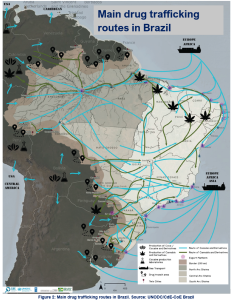This website uses cookies so that we can provide you with the best user experience possible. Cookie information is stored in your browser and performs functions such as recognising you when you return to our website and helping our team to understand which sections of the website you find most interesting and useful.
MARITIME DRUG SMUGGLING & TRAFFICKING IN BRAZIL – IMPLICATIONS FOR SHIP OWNERS AND CREW
Published: 6 November 2023
Brazil’s strategic position in South America, with an extensive coastline and numerous ports, renders it a prime choice for drug trafficking organisations seeking to transport illicit drugs to lucrative markets in Europe, North America, and other regions across the globe. The use of maritime ships for drug smuggling in Brazil is a complex and evolving problem as smugglers employ a variety of ships and tactics to conduct their illegal trade.
Unfortunately, the discovery of illicit drugs on board can put the crew in a very difficult situation. It is therefore important that shipowners demonstrate due diligence and take appropriate measures to prevent drugs being brought on board their ships.
To assist shipowners and their crew we would like to draw their attention to the information previously shared by Brazilian P&I correspondent RROINDE on maritime cocaine trafficking in Brazil which highlights the main drug trafficking routes in Brazil. Shipowners should implement preventive measure when calling these areas:
Source: PROINDE
Furthermore, another Brazilian correspondent has issued guidance because of the increase of smuggling of narcotics on board ships in Brazil, which highlights some useful precautionary measures to be taken while operating in Brazilian waters.
The Club also continues to raise awareness around drug smuggling and the severe consequences it may have for Members and their crew. As part of its award winning BSafe Campaign, the Club’s loss prevention department has issued guidance covering on board security as well as drug smuggling prevention. These contains further advice around increasing on board security if a ship is calling at ports with an increased risk of drug trafficking. Here are some measures to consider:
- Contact local correspondents, agents, or authorities for updated advice on the potential risk of smuggling
- Assess the security risks in conjunction with the Ship Security Plan (SSP) to ensure that appropriate mitigation measures are implemented
- Identify and monitor all access points to prevent unauthorised access
- Use appropriate and robust identification system for all visitors
- Closed circuit television cameras (CCTV) can be used as a further mean of monitoring and recording activity on deck
- Maintain vigilance while in port or at anchor, including frequent security patrols
- Observe the cargo operation especially when a cargo hold is being ‘topped up’ to ensure that no packages are placed on top of the cargo as the hatch covers are about to be closed
- Keep areas, such as accommodation and deck stores, locked in port
- Maintain illumination of deck areas and access points
- Consider the installation of physical barriers such as metal gratings above any accessible openings to the rudder spaces
- Conduct a thorough search of the ship, including the use of sniffer dogs and divers to inspect the submerged parts of the hull
Lastly, it is important for crew members to always remember to prioritise personal safety. Due to the nature of their activity, smugglers may be dangerous and armed. It is advisable to avoid direct contact with any smugglers, and instead report any suspicious behaviour to the watchkeeping officer.
For further information, please do not hesitate to contact the loss prevention department.

 English
English
